
Toledo is a city and municipality of Spain, the capital of the province of Toledo and the de jure seat of the government and parliament of the autonomous community of Castilla–La Mancha.

The Tagus is the longest river in the Iberian Peninsula. The river rises in the Montes Universales between Cuenca and Teruel, in mid-eastern Spain, flows 1,007 km (626 mi), generally westward, and empties into the Atlantic Ocean in Lisbon.
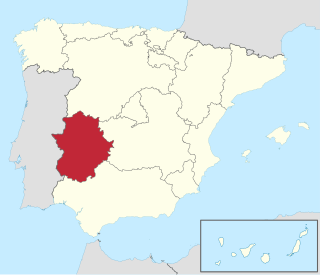
Extremadura is a landlocked autonomous community of Spain. Its capital city is Mérida, and its largest city is Badajoz. Located in the central-western part of the Iberian Peninsula, it is crossed from east to west by the Tagus and Guadiana rivers. The autonomous community is formed by the two largest provinces of Spain: Cáceres and Badajoz. Extremadura is bordered by Portugal to the west and by the autonomous communities of Castile and León (north), Castilla–La Mancha (east), and Andalusia (south).
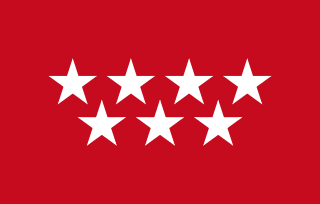
The Community of Madrid is one of the seventeen autonomous communities of Spain. It is located in the centre of the Iberian Peninsula, and of the Central Plateau. Its capital and largest municipality is the City of Madrid, which is also the capital of the country. The Community of Madrid is bounded to the south and east by Castilla–La Mancha and to the north and west by Castile and León. It was formally created in 1983, in order to address the particular status of the City of Madrid as the national capital city and in urban hierarchy. Its limits are those of the province of Madrid, which was until then conventionally included in the historical region of New Castile.

Castilla–La Mancha is an autonomous community of Spain. Comprising the provinces of Albacete, Ciudad Real, Cuenca, Guadalajara and Toledo, it was created in 1982. The government headquarters are in Toledo, which is the capital de facto.
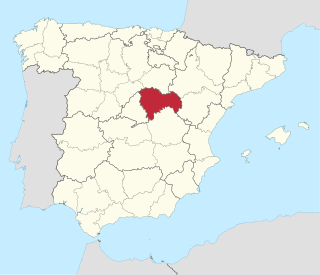
Guadalajara is a province of Spain, belonging to the autonomous community of Castilla–La Mancha. As of 2019 it had a population of 258,890 people. The population of the province has grown in the last 10 years. It is located in the centre of the Iberian Peninsula.

Aranjuez is a city and municipality of Spain, part of the Community of Madrid.
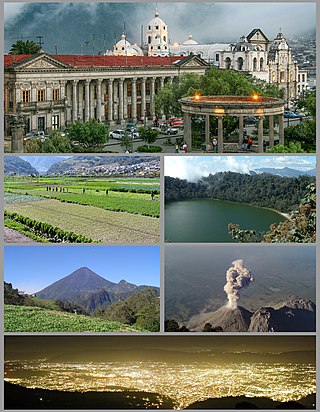
Quetzaltenango is a department in the western highlands of Guatemala. The capital is the city of Quetzaltenango, the second largest city in Guatemala. The department is divided up into 24 municipalities. The inhabitants include Spanish-speaking Ladinos and the Kʼicheʼ and Mam Maya groups, both with their own Maya language. The department consists of mountainous terrain, with its principal river being the Samalá River. the department is seismically active, suffering from both earthquakes and volcanic activity.

The Manzanares is a river in the centre of the Iberian Peninsula, which flows from the Sierra de Guadarrama, passes through Madrid, and eventually empties into the Jarama river, which in turn is a right-bank tributary to the Tagus.
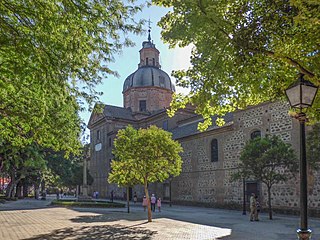
Talavera de la Reina is a city and municipality of Spain, part of the autonomous community of Castile–La Mancha. Its population of 83,303 makes it the second most populated municipality of the province of Toledo and the fourth largest in the region.

Federico Jorge Jiménez Losantos, also known by his initials FJL, is a Spanish radio presenter and right-wing pundit, being most known for his successful radio talk show Es la mañana de Federico. He is also a TV host and literary and non-fiction author. A member of extreme-left organizations and participant in Barcelona's counter-cultural scene in the 1970s, he experienced a radical rightward drift, eventually becoming a journalistic guru for a far-right audience.

Ocaña is a municipality of Spain, in the province of Toledo, Castilla–La Mancha.
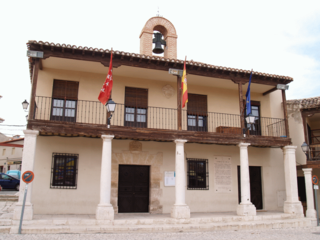
Colmenar de Oreja is a town and municipality of the Las Vegas comarca, in the Community of Madrid, Spain. It was subject to a seven-month siege in 1139.

Pedro Fernández de Castro "the Castilian" was a Castilian nobleman, son of Fernando Rodríguez de Castro and Estefanía Alfonso la Desdichada. He inherited the Infantazgo of León from his parents and was mayordomo mayor of Fernando II and his son Alfonso IX of León.

The Tagus-Segura Water Transfer is one of the largest works of hydraulic engineering ever produced in Spain. Water from the Tagus River is channeled through this transfer system from the reservoirs of Entrepeñas and Buendía into the Talave Reservoir on the Segura River.

Alto Tajo Nature Reserve is a Natural Reserve in Guadalajara Province of Spain. The park is famous for its canyons and gorges formed by the Tagus river and its tributaries which flow through the park, besides its pine forests and imposing cliffs. The park provides the setting for José Luis Sampedro's novel El río que nos lleva (1961). The park was also one of the filming locations of Game of Thrones.

José María "Txema" Portillo Valdés is a Spanish historian, professor of Contemporary History at the University of the Basque Country. He is an expert in Spanish constitutional history.

The Guadiela is a river in the Iberian Peninsula, a left-bank tributary of the Tagus and the latter's major upper-course tributary.
The history of the territorial organization of Spain, in the modern sense, is a process that began in the 16th century with the dynastic union of the Crown of Aragon and the Crown of Castile, the conquest of the Kingdom of Granada and later the Kingdom of Navarre. However, it is important to clarify the origin of the toponym Spain, as well as the territorial divisions that existed previously in the current Spanish territory.



















